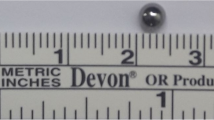Abstract.
Background: The study was performed to determine (1) whether intravitreous ferromagnetic foreign bodies (FBs) are sufficiently mobile in a magnetic field to induce acute injury in vivo, and (2) whether the length of time from implantation of the intravitreous FB affects mobility. Methods: A 3 mm × 0.72 mm magnetic FB (MFB) and a non-magnetic metallic FB (NMFB) of similar dimensions were surgically implanted into the right and left eyes, respectively, of 20 New Zealand white rabbits. On days 0 (FB implantation) and 30, all rabbits underwent computed tomography (CT) prior to and immediately following exposure to a 1.5-tesla (T) magnetic field. Pre- and post-magnetic field CT image FB angles and distances, together with ophthalmic examinations, were used to assess FB mobility. Rabbits were killed at 31 days. The globes were processed for light microscopy (LM) and scanning electron microscopy (SEM). Results: Angle measurements revealed that the MFBs developed significant angular motion and were scattered more widely than NMFBs on the day of FB implantation and 30 days later, although the angular motion and scatter of MFBs were less on day 30 . There were no significant differences among distance measurements for MFBs or NMFBs on or between days 0 and 30. Throughout the 30-day study, ophthalmic examinations revealed dorso-ventral FB movement and focal vitreous degeneration and retinal hemorrhage within both MFB- and NMFB-containing globes. Mild vitreous hemorrhage was noted around a NMFB. Focal retinal degeneration was confirmed by LM (n=1 MFB). SEM revealed intravitreous erythrocytes and spindle cells adjacent to all FBs examined. Conclusions: (1) Angle measurements show that MFBs are significantly mobile when exposed to a 1.5-T magnetic field on the same day as FB implantation and 30 days later. (2) Angular mobility of MFBs is less at 30 days. (3) Magnetic field exposure did not induce ocular injury in MFB-containing globes. (4) Intravitreous metallic FB retention induces ocular pathologic changes.
Similar content being viewed by others
Author information
Authors and Affiliations
Additional information
Electronic Publication
Rights and permissions
About this article
Cite this article
Cullen, C., Kendall, E., Cui, J. et al. The effects of exposure to a 1.5-tesla magnetic field on intravitreous metallic foreign bodies in rabbits. Graefe's Arch Clin Exp Ophthalmol 240, 393–402 (2002). https://doi.org/10.1007/s00417-002-0434-6
Received:
Revised:
Accepted:
Published:
Issue Date:
DOI: https://doi.org/10.1007/s00417-002-0434-6




